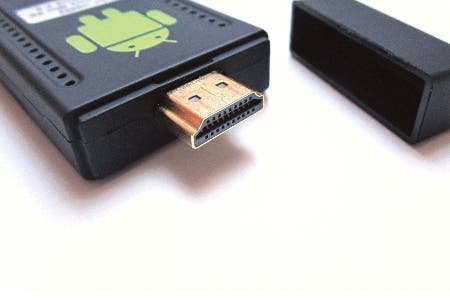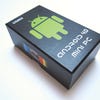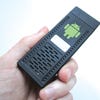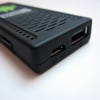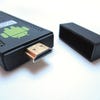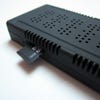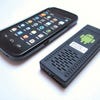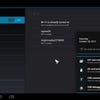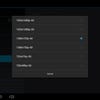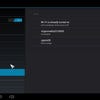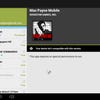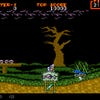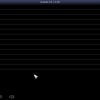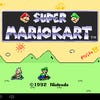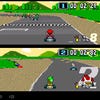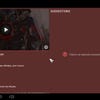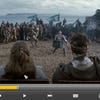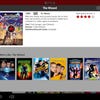Android on a stick: Klastor UG802 review
£30 for an ultra-portable dual-core media centre with the same GPU as the Samsung Galaxy S3? Digital Foundry investigates.
Bankrolled by over 60,000 people to the tune of more than $8 million, the Ouya console is a poster child for Kickstarter's uncanny ability to transform vague dreams into solid reality. The team behind the Android-based system are out to create an affordable yet powerful domestic platform which showcases the best of both indie and mainstream video games. However, with the Ouya still little more than a prototype, it has been beaten to the punch by China's industrious tech wizards.
We've already seen all-in-one Android devices that connect to your telly and measure no more than a USB memory stick, but thus far they've been too underpowered to warrant closer inspection. However, the snappily-titled Klastor UG802 Android TV-PC is packing a Rockchip RK3066, which is comprised of a dual-core Cortex A9 CPU and a quad-core Mali 400 graphics processor - a similar arrangement to that seen in Archos' forthcoming GamePad.
While it's not quite in the same league as Tegra 3 devices such as the Nexus 7, Asus Transformer Prime and aforementioned Ouya console, the raw specs are still worthy of note - the same combination of CPU and GPU has been used in many high-quality smartphones with some decent gaming performance. The amount of power on display here would suggest that the UG802 could potentially steal a march on Ouya when it comes to turning your humble television into a multimedia powerhouse capable of hosting the latest Android games, streaming HD video, playing music and surfing the internet - and all for less than £50. (We procured our review unit for £30, but the price has since risen to £45 at the time of writing).
Design and hardware
Clad in matte-touch plastic and looking strangely like a harmonica, the UG802 is slightly larger than a USB stick, but still impressively compact. It weighs just 40 grams and effortlessly slips into your pocket - in fact, it's smaller than your typical mobile phone.
A closer inspection of the casing reveals a standard USB socket, as well as Micro USB port alongside it. There's also a MicroSD card slot, but you'll have to source your own as one isn't included (2GB of internal flash storage is offered out of the box). Moving to the opposite end of the unit, a male HDMI connector resides underneath a removable cover designed to offer protection when it transit. Using this port, you can plug the UG802 straight into an HDMI socket on your television, but if you find that to be too snug a fit, you can use the bundled female to male HDMI cable. There's also a MicroUSB cable in the box as well - an essential item, as this is used to provide power.
Curiously, there's no power switch on the UG802. As soon as the MicroUSB lead is connected to a power source, the unit springs to life. The only way of turning it back off again is to yank the lead out - a strangely counter-intuitive procedure that can result in data loss if the lead is yanked while the UG802 is performing a task, such as syncing documents or saving application information.
Divorced from the traditional Android touch-screen interface, the UG802 relies on USB peripherals for interaction. It's possible to plug in a USB mouse and use the on-screen soft keyboard via the mouse pointer - something which is a lot less awkward in practice than it might sound. As there's no Bluetooth chip inside the unit, you'll need to purchase wireless peripherals if you wish to use them in tandem - such as a mouse and keyboard, for example.
Software and performance
Ice Cream Sandwich is the flavour of Android that's installed on the UG802 - version 4.0.4, to be precise. The UI has been heavily customised to suit the fact that you have no access to a touch-screen; the splash menu is a series of large, friendly buttons, with the main Android menu bar menu concealed from view. However, drop into an app and it re-appears, allowing you to access the home screen, multi-tasking panel and even change the volume (a requirement forced by the fact that the unit has no physical volume controls).
"The UI has been heavily customised to suit the fact that you have no access to a touchscreen; the splash menu is a series of large, friendly buttons, with the main Android menu bar menu concealed from view."
At times, the stock Android UI shines through. Opening up the settings app drops you back into the familiar vista of Android 4.0, which is quite jarring in a way - you have to get used to mimicking the actions that your finger would perform on a touch-screen, but with a mouse pointer instead. Cycling through menus can be done using your mouse's scroll wheel, but for those times when that doesn't work, you need to become accustomed to some pretty deft clicking and wrist-flicking.
Despite being built on the Android 4.0 framework, the firmware included with the UG802 is hopelessly buggy and unstable. Apps often take several attempts to load, and the "App not responding" dialogue box pops up with unnerving regularity. During our review, we also experienced several unexpected reboots, although some of these seem to be connected to the use of a USB hub, which seems to have been drawing too much power from the device. Using a powered hub may possibly solve this issue, but we sadly didn't have one to hand during the test. Even when we weren't using the USB, crashes were still infuriatingly commonplace.
Issues relating to the Wi-Fi also became apparent - something which appears to be a common problem with many units released thus far. The wireless signal often drops out unexpectedly, and even when it's connected, the speed is usually atrocious. Modders have so far suggested exotic solutions such as opening the case and exposing the Wi-Fi antenna, but there's the hope that it can be fixed using a software upgrade. With this being Android, custom ROMs are already available, but provide inconclusive results - reports indicate that the Wi-Fi problem remains even when flashing new firmware to the device.
"Benchmarks suggest that this little stick keeps up with dual-core Android phones in terms of CPU power and packs a surprising level of punch in the GPU department."
| Samsung Galaxy Nexus (Android 4.1) | HTC One X | Klastor UG802 | |
|---|---|---|---|
| AnTuTu | 4724 | 11065 | 6517 |
| Vellamo | 1199 | 1661 | 1271 |
| GLBenchmark 2.5.1 (2.1 Egypt Classic Offscreen) | 14.8FPS | 38.7FPS | 47FPS |
One of the major applications of the UG802 is streaming video, effectively turning your humble television into an all-singing, all-dancing smart TV. That's the dream, but in reality things are a little less impressive. The aforementioned Wi-Fi problem impacts the unit's ability to comfortably handle HD footage, and even when you do get playback, the sound and image are often disconnected. While the UG802 has no issues running Netflix and YouTube, it struggled with Google's Play Movies service - audio was hopelessly out of sync and video was choppy.
Interestingly, audio remained out of sync even when watching videos from an SD card and using the UG802's preinstalled movie player. It was possible to overcome this limitation by installing MV Player from the Google Play market and running in software (as opposed to hardware) mode.
Gaming credentials
Given that the UG802 features an impressive coupling of CPU and GPU power, it's reasonable to expect some decent gaming performance from the unit. For 2D titles like Jetpack Joyride and Canabalt, this is certainly the case - performance is generally comparable to that seen on a top-tier Android mobile phone.
Of course, with many Android games being built around a touch-screen interface, control is an issue. Using a USB mouse you can play titles which require simple input, but multi-touch is obviously off the table, so games which utilise pinch-to-zoom - such as Rovio's Angry Birds series - are only half-playable.
When you step into the world of 3D gaming, the results become somewhat less appealing. Many games - such as Grand Theft Auto 3 and Max Payne Mobile - aren't compatible with the UG802 and won't install from the Google Play market. Even when you do find a technically demanding 3D title that will download to the system, it's very much a game of chance as to whether or not it will load - a great many of the titles we installed steadfastly refused to boot up at all. This is a massive disappointment bearing in mind the potential we see from the benchmarks - the scores seem to confirm that this is indeed the same quad-core Mali 400 found in the Samsung Galaxy S3, simply running at a lower clockspeed (47FPS from the UG802 on the GLBenchmark test, vs. 59.1FPS from the S3).
"2D titles not reliant on multi-touch work very well indeed, but 3D app performance is a major disappointment bearing in mind the capabilities of the onboard GPU."
Another issue is that the UG802 doesn't currently support the Xbox 360 wired pad - despite the fact that practically every other Android device we've used auto-detects the controller without any fuss. This means that games like Dead Trigger - one of the few recent 3D titles that runs half-decently on the unit - is rendered unplayable, because without a touch-screen you have no option but to use a pad. The PlayStation 3 DualShock controller - running through its wired USB cable connection - works in a fashion, but you have to keep tapping the PlayStation button in the middle of the pad to maintain the connection, otherwise it keeps dropping out. Again, this sounds like it could be a power issue, with the UG802 not able to keep the pad 'awake' during use.
To confuse matters further, our trusty (and very old) Logitech Precision USB pad is instantly recognised by the UG802, but cannot be used with Dead Trigger as it lacks the required analogue stick. Thankfully, the digital control it does offer comes in very handy for another element of gaming on the device: retro emulation.
It's a shadowy practice, but for those willing to dip a toe into the murky waters of emulation, the UG802 suddenly becomes a much more appealing prospect. As a rule, the emulators available on Android are less taxing on the unit's internal tech, and replication of 8 and 16-bit platforms is largely flawless. We were able to disable frame skip on several emulators and run games at full speed - although when the UG802 was engaging in other activities - such as syncing emails - a brief amount of slowdown occurred. SNES, Neo Geo, PC Engine, NES, Game Boy and Neo Geo Pocket Color are all supported - as well as several other systems - effectively allowing you to imbue your television with 30 years of gaming history in one fell swoop.
Klastor UG802 - the Digital Foundry verdict
The UG802 is interesting because it can be seen as a validation of the concept behind the still-to-be-released Ouya system. Many people have suggested that there's no way that Ouya can come in on time and to budget. However, bearing in mind that the UG802 cost us just £30 from Amazon and features a pretty powerful SoC, the notion of the more expensive Ouya being able to pack Tegra 3 power into a machine the size of a Rubik's cube suddenly seems a lot more viable. But can Google's Android platform really be married with a TV to create a new console platform?
Sadly, a litany of issues means that the UG802 can't answer that question with any degree of satisfaction, although at times it does provide a tantalising glimpse of what Ouya may provide when it does eventually hit the market. But there's enough evidence from our testing to suggest that if time and effort was put into stabilising the OS, this £30 "Android on a stick" could be a superb little media player and games machine. But in the here and now, the product simply isn't good enough.
"The Klastor UG802 looks so exciting in terms of the amount of power you get at its ultra-low price-point, but unfortunately the package is let down badly by dire system stability and woeful WiFi range."
After facing numerous crashes, freezes and Wi-Fi drop-outs - not to mention skipping audio and laughably poor USB peripheral support - it's hard not to come to the conclusion that the UG802 is a half-finished product which really could have benefitted from more time in development. The software is buggy, the stability terrible and internal tech flawed. Although there's hope that the Wi-Fi problem can be solved via software, hacks involving the exposure of the antenna hint that the fault is a physical one, which renders the device almost useless in the long term. Even when the wireless connection is in place, the transfer speed is rarely any better than abysmal. As a media device, the UG802 again feels half-done, thanks to irksome audio problems.
The only thing we found the UG802 genuinely useful for was emulation, which is a practice of which not every potential owner is going to be in favour. Being able to hook the unit up to your television to play Super Mario World is indeed neat, but this has been a common feature of Android for quite some time now, and it's perfectly possible to connect many tablets and phones via HDMI and achieve exactly the same experience - albeit with less exasperating hair-pulling.
Even for the incredibly low price, it's hard to recommend the UG802 to anyone but the most dedicated hacker. Over time, custom firmware may solve some of its more debilitating problems, but flashing ROMs to the device is not as easy as it sounds - just getting the average PC to recognise the UG802 is a task in itself due to the difficulty in sourcing the required USB drivers, and a bad flash can result in a bricked device. If you're eyeing up this unit as an 'out of the box' experience, don't bother - you're going to have to put a lot of effort in to get results, and even then, you'll have to endure some frustratingly unreliable software.
